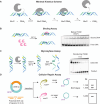FSHing for DNA Damage: Key Features of MutY Detection of 8-Oxoguanine:Adenine Mismatches
- PMID: 38471078
- PMCID: PMC10993402
- DOI: 10.1021/acs.accounts.3c00759
FSHing for DNA Damage: Key Features of MutY Detection of 8-Oxoguanine:Adenine Mismatches
Abstract
Base excision repair (BER) enzymes are genomic superheroes that stealthily and accurately identify and remove chemically modified DNA bases. DNA base modifications erode the informational content of DNA and underlie many disease phenotypes, most conspicuously, cancer. The "OG" of oxidative base damage, 8-oxo-7,8-dihydroguanine (OG), is particularly insidious due to its miscoding ability that leads to the formation of rare, pro-mutagenic OG:A mismatches. Thwarting mutagenesis relies on the capture of OG:A mismatches prior to DNA replication and removal of the mis-inserted adenine by MutY glycosylases to initiate BER. The threat of OG and the importance of its repair are underscored by the association between inherited dysfunctional variants of the MutY human homologue (MUTYH) and colorectal cancer, known as MUTYH-associated polyposis (MAP). Our functional studies of the two founder MUTYH variants revealed that both have compromised activity and a reduced affinity for OG:A mismatches. Indeed, these studies underscored the challenge of the recognition of OG:A mismatches that are only subtly structurally different than T:A base pairs. Since the original discovery of MAP, many MUTYH variants have been reported, with most considered to be "variants of uncertain significance." To reveal features associated with damage recognition and adenine excision by MutY and MUTYH, we have developed a multipronged chemical biology approach combining enzyme kinetics, X-ray crystallography, single-molecule visualization, and cellular repair assays. In this review, we highlight recent work in our laboratory where we defined MutY structure-activity relationship (SAR) studies using synthetic analogs of OG and A in cellular and in vitro assays. Our studies revealed the 2-amino group of OG as the key distinguishing feature of OG:A mismatches. Indeed, the unique position of the 2-amino group in the major groove of OGsyn:Aanti mismatches provides a means for its rapid detection among a large excess of highly abundant and structurally similar canonical base pairs. Furthermore, site-directed mutagenesis and structural analysis showed that a conserved C-terminal domain β-hairpin "FSH'' loop is critical for OG recognition with the "His" serving as the lesion detector. Notably, MUTYH variants located within and near the FSH loop have been associated with different forms of cancer. Uncovering the role(s) of this loop in lesion recognition provided a detailed understanding of the search and repair process of MutY. Such insights are also useful to identify mutational hotspots and pathogenic variants, which may improve the ability of physicians to diagnose the likelihood of disease onset and prognosis. The critical importance of the "FSH" loop in lesion detection suggests that it may serve as a unique locus for targeting probes or inhibitors of MutY/MUTYH to provide new chemical biology tools and avenues for therapeutic development.
Conflict of interest statement
The authors declare no competing financial interest.
Figures






References
-
- Majumdar C.; McKibbin P. L.; Krajewski A. E.; Manlove A. H.; David S. S. Unique H-Bonding Pattern of Adenine with the Oxidatively Damaged Base 8-Oxoguanine Enables Specific Recognition and Repair by DNA Glycosylase MutY. J. Am. Chem. Soc. 2020, 142, 20340–20350. 10.1021/jacs.0c06767. - DOI - PMC - PubMed
-
- Lee A. J.; Majumdar C.; Kathe S. D.; Van Ostrand R. P.; Vickery H. R.; Averill A. M.; Nelson S. R.; Manlove A. H.; McCord M. A.; David S. S. Detection of OG:A Lesion Mispairs by MutY Relies on a Single His Residue and the 2-Amino Group of 8-Oxoguanine. J. Am. Chem. Soc. 2020, 142, 13283–13287. 10.1021/jacs.0c04284. - DOI - PMC - PubMed
Publication types
MeSH terms
Substances
LinkOut - more resources
Full Text Sources
Medical
Research Materials
Miscellaneous

